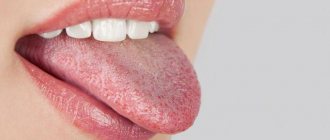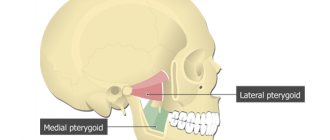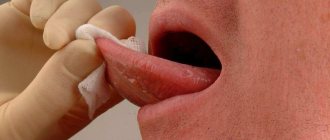Root or core callus is the most difficult type of callus to treat. A callus has a core (root) that is located deep in the skin and can even penetrate into soft tissue. This is a late stage of dry callus development.
Externally, such a callus looks like an area of keratinized skin, and inside it a funnel is visible. The formation is quite dense and causes pain when walking. In some cases, it is completely impossible to walk with such a callus - when the rod is already located deep enough and has penetrated into the soft tissue, squeezing the nerve endings.
Most often, calluses appear on the toes, under and between them, and on the heels. Interdigital calluses are the most painful.
What does it represent?
In medical terminology, a pip or callus is called glossitis. This is an inflammatory disease of the tissue fibers of the receptor organ (tongue), caused by the formation of cracks, mechanical damage, wounds or burns on the mucous tissues of the organ where the infection penetrates.
In other words, any cuts on the tongue facilitate the active penetration of bacteria into them, which instantly cause inflammation, redness and create great discomfort.
Glossitis is one of the most common oral pathologies. Children, especially young ones under 5 years of age, are at high risk. They are the ones who pull dirty toys and hands into their mouths, thereby allowing bacteria to penetrate and infect mucous tissues.
Podologist's advice
- Treat wet calluses in a timely manner, which over time can transform into dry calluses and then into core calluses.
- Wear shoes that fit comfortably. Avoid shoes with too thin soles. Don't wear stilettos all the time.
- Socks should be made from natural fabrics.
- Use antiperspirant for your feet if you suffer from excessive sweating.
- Maintain personal hygiene and do not wear other people's shoes.
- Watch your weight and use orthopedic insoles if necessary. It is not recommended to select them yourself; to do this, contact a specialist.
Causes
As already mentioned, glossitis occurs as a result of damage to the integrity of the soft tissues of the receptor organ. But this is not the only reason.
Quite often, a callus on the tongue does not appear as a separate disease, but indicates the presence of more serious pathologies of the body.
There is a list of factors that, to some extent, can influence the development of glossitis. So, the main causes of calluses on the tongue are as follows:
- Injuries to the mucous tissue and fibers of the tongue. This can be cuts from cutlery, sharp edges of lollipops or sucking sweets, biting the tongue, piercing with a fish bone, damage to the shell from seeds, stale food (bagels, crackers, crispbread, etc.).
- Prolonged sucking of lollipops also leads to damage to the mucous membrane, because such products cause tissue irritation.
- Irritation of the mucous membranes as a result of eating hot, spicy and very salty foods.
- Any allergic reaction to any food can cause swelling of the tongue, which develops into an infectious inflammation.
- Carbonated drinks, concentrated juices, sweet water. All these products contain large amounts of citric acid, which in high concentrations can burn the mucous tissues of the oral cavity. You should be especially careful when drinking alkaline water.
- Drinking alcohol, as alcohol corrodes soft tissue.
- Smoking. Nicotine contained in tobacco consists of 30% heavy salts that burn mucous tissues.
- Very often, the cause of a callus on the tongue can be various types of dental diseases, such as periodontitis, stomatitis or gingivitis.
- Oxidative reactions in the mouth resulting from the installation of braces or plates made of low-quality metals.
- Lack of vitamins, in particular lack of protein and amino acids.
- Acute diseases of the liver, gall bladder, pancreas.
- Poor oral hygiene. Everyone brushes their teeth at least twice a day, but you shouldn’t forget about your tongue. The plaque that accumulates on it indicates that the pores are clogged with food debris.
- Ulcers on the tongue also occur as a concomitant symptom of diseases such as scarlet fever, measles, rubella, and syphilis.
- Infestation caused by worms and other intestinal parasites.
Quite often, small pimples on the tongue can appear during acute respiratory diseases, such as purulent tonsillitis.
It should be remembered that a pip on the tongue is the cause of a condition such as pain, nervousness, and it must be treated regardless of its origin.
Signs
When a callus appears on the tongue, the patient may feel a burning and tingling sensation. If the callus is located at the tip of the organ, numbness may also be present. With a large callus, the patient may complain of pain while eating. In this case, the tongue often swells, increases in size and becomes bright red.
The callus itself looks like a skin pimple, inside of which there is serous exudate. In the absence of proper treatment, this exudate is replaced by pus, resulting in the formation of an abscess on the mucous membrane.
Subsequently, a bleeding wound appears at the site of the callus. It brings the patient much more unpleasant sensations than a callus. In addition, it is more difficult to treat.
Symptoms
The most important thing is to be able to distinguish ordinary glossitis from inflammation caused by various diseases. At the first signs of pathology, it is recommended to consult a doctor.
Among the main symptoms of calluses on the tongue are:
- changes in the color of the tongue, it can become brighter (rich red or crimson) or, conversely, fade, changing color to white-pink;
- the formation of a large amount of plaque, causing an unpleasant taste and sensation in the mouth;
- small spots that appear in a specific area or throughout the tongue;
- swelling of the tip of the tongue, in which the pores are clearly visible, the surface looks loose;
- tissue compaction, roughening, appearance of small blisters;
- callus can have different shapes - it can be in the form of a purulent abscess, plaque, small tissue compaction, inflammation;
- the tongue may dry out and crack;
- compacted tissues cause discomfort, especially when chewing food, causing sharp pain and burning.
Even the slightest changes in the mucous tissues and fibers of the tongue, which are hardly noticeable to the naked eye, are clearly noticeable, so violations will become known from the very beginning.
Possible complications of core calluses
Lack of timely treatment of callus can lead to complications. The root of the callus is able to penetrate deep enough into the skin, squeezing the nerve endings. The patient's gait may change, even to the point of lameness, which even leads to disability - the pain caused by the callus can be so intense.
Calluses on the heels can bleed and fester. In this case, you need to contact a specialist immediately - such symptoms indicate the presence of an inflammatory process in the callus.
Diagnostics
As mentioned earlier, at the first signs of inflammation of the mucous tissues of the oral cavity, you need to consult a therapist who can determine the severity of the disease and prescribe additional examinations from doctors of a more specialized profile.
As a rule, the diagnosis of glossitis consists of the following steps:
- General examination by a general practitioner.
- Examination of the oral cavity and ENT organs by an otolaryngologist.
- Saliva analysis.
- Analysis of scraping plaque and saliva from the site of inflammation.
- Analysis of pus in the presence of purulent inflammation.
- If necessary, general and extended (biochemistry) blood tests can be performed.
As a rule, all of the above diagnostic methods are quite sufficient to determine the root causes of glossitis formation. A study of saliva and scrapings with pus will help determine the etiology of the disease and determine whether it was caused by a virus or an ordinary infection.
If the problem lies deeper, blood tests will show deviations from the norm in certain indicators, which will become the basis for further, more detailed examination.
Treatment of root callus
The treatment regimen is selected depending on the cause of callus formation and always involves the removal of the stratum corneum and the core of the formation. It is important to completely remove the root of the callus, otherwise the problem will recur again and again.
The easiest way to remove dead skin is with a hardware pedicure. The specialist selects the diameter of the machine's cutters, which are used to cut the skin, depending on the size of the callus and the depth of its core.
After removing the rod, its bed is treated with an antiseptic. Then an antibacterial ointment is placed in it.
Nutrition
The first step is to remove the load from the tongue so that the disease does not worsen. To do this, use a special diet that limits the consumption of salty, sweet, pepper and spicy foods, and excludes alcohol, carbonated drinks, juices, various sauces, ketchup and mayonnaise from the diet.
Food should be soft, easy to chew, without touching the inflamed areas. This could be mashed potatoes, soy pudding, chicken broth, fruit yoghurts.
If the cause of the callus is an infection, the consumption of fermented milk products is strictly prohibited. The bacteria it contains create a favorable environment for the development of pathogenic organisms, which can aggravate the situation and slow down the treatment process.
Drug treatment
To eliminate pain, discomfort and relieve inflammation, doctors recommend using painkillers, non-steroidal anti-inflammatory drugs, such as Ibuprofen, Ledocaine, Drotaverine.
In case of severe damage, agents are prescribed that accelerate the processes of restoration of mucous tissues. For example, “Glutamine”, “Imudon”.
To eliminate the infection, you must regularly rinse your mouth every 2 hours. For this purpose, special solutions are used - “Furacilin”, “Chlorhexodine”, “Hexoral”.
Prevention
The main rule for preventing calluses on the tongue is to regularly increase immunity (if the body’s defenses are weakened, a tip will form on the patient’s tongue from time to time, even if it has previously been successfully treated).
To do this, you need to eat properly and balanced, play sports, harden yourself, follow a work and rest schedule, stop smoking and drinking cigarettes, avoid stressful situations, and also use drugs with lactobacilli after completing a course of antibiotic treatment. For this purpose, you can also purchase Echinacea tincture and fish oil at the pharmacy. They have a low cost and are sold without a doctor’s prescription, but at the same time they bring incredible benefits to the body.
Oral hygiene should be carried out regularly - it consists not only of brushing your teeth, but also your tongue, as well as rinsing your mouth after each meal.
You should visit the dentist for a preventive examination of the oral cavity and detect diseases at the earliest stages at least once a year. Treatment of any dental diseases should be carried out as soon as possible.
Patients prone to allergic reactions should be extremely careful with new foods (especially exotic ones) and oral care products.
Folk remedies
If the inflammation is minor, many recommend treating tongue tip at home using both traditional medicine and pharmacy analogues.
The best way to relieve inflammation and disinfect the oral cavity is chamomile infusion. An infusion of oak bark will help heal ulcers and cuts, if any.
In pharmacies you can also buy ready-made concentrates of celandine, calendula, nettle or St. John's wort for rinsing the mouth. It is recommended to lubricate small pustules with sea buckthorn oil or rosehip oil.
Folk treatment of pipuna
To speed up the healing process, the patient can use non-traditional methods of therapy along with traditional ones.
Bee products are often used for this purpose. For example, propolis tincture or liquid honey. In this case, you need to lubricate the tongue in the affected area with medicines or apply a cotton pad soaked in the product to the tip and hold the compress for 10-15 minutes. Toothpastes containing propolis also have a healing effect.
Bee products quickly relieve inflammation, irritation and accelerate tissue regeneration. Despite their enormous benefits for the body, the use of honey by patients prone to allergic reactions is still not recommended, since in this case the risk of side effects cannot be excluded.
For calluses on the tongue, the juice of raw potatoes can be of great benefit. To do this, you need to take several medium-sized potatoes, peel them and grind them in a meat grinder, then squeeze out the juice using several layers of gauze. You need to dip a cotton pad in the juice of this root vegetable, and then apply it to the affected area, but there is no need to press on the area. You need to hold such a compress for quite a long time (the longer the better), but in any case the procedure should not last less than 10 minutes. With the help of such a compress, you can eliminate inflammation and draw fluid out of the tip.
Horseradish can also help in treating calluses. In this case, you need to pour 100 g of plant root minced in a meat grinder into 100 ml of distilled water. After this, the container with the ingredients must be placed on the fire, brought to a boil and boiled in this way for 15 minutes. You need to make compresses from the prepared broth in the morning and evening for 5-10 minutes. This remedy cauterizes the callus and relieves inflammation.
If you don't have horseradish root, you can use garlic. To do this, cut a clove of garlic in half and attach it to the tip. The course of treatment is until the symptoms of the disease disappear completely.









